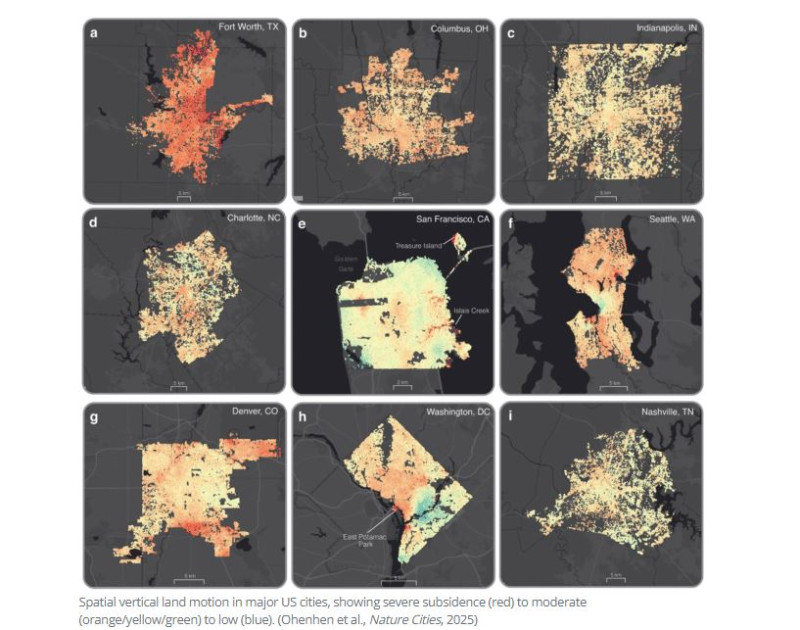In which areas are the fastest sedimentation rates – the risks – the worrying trend to be dealt with in time
A new study using radar satellites has revealed that the 28 most densely populated US cities are sinking due to urbanization, drought or rising sea levels – to a different degree in each case.
In each of the cities studied, at least 20% of the city showed some form of sedimentation between 2015 and 2021. Even more worrying is the fact that 25 of the 28 cities, at least 65% of the area, seems to sink, as scienceealert.com reports.
From coasts to inland, researchers estimate that these metropolises host nearly 34 million people – about 12% of the total US population. Although these cities are not at risk of immediate collapse, sedimentation is a worrying tendency to be addressed in time.
“Settlement is a sneaky, highly local and often unrecognized problem, compared to the overall rise in sea level, but is an important factor that explains why water levels rises to many parts of the east coast of the US.”had stated in 2024 by the Geophysical Leonard Ohenhen.
In his new study, the researcher reports that in cities such as Chicago, Dallas, Columbus, Detroit, Fort Worth, Denver, New York, Indianapolis, Houston and Charlotte, over 98% of the urban area. Cities that record particularly high sedimentation- more than 2mm per year- are New York, Chicago, Houston, Dallas, Fort Worth, Columbia, Seattle and Denver.
Particularly in the state of Texas, Fort Worth, Dalas and Houston cities record the fastest rates of sedimentation at national level, exceeding average 4mm per year. In other cities, places have been identified where the sedimentation rate exceeds 5mm a year, such as Treasure island in San Francisco and areas around the Gulf of Islais Creek.
Scientists agree that rates of more than 5mm per year are a serious threat to cities. But even at lower levels, uneven seats can cause significant damage to roads, buildings and bridges. In cities such as New York, Las Vegas and Washington, severe deviations in the pace from region to region threaten cracks and destabilizing critical infrastructure. When the soil is sinking quite a bit, the risk of flooding increases.
The authors of the study- scientists from various American scientific institutions- estimate that more than 29,000 buildings in large American cities are in areas with high or very high risk of being damaged.
“The latent nature of this danger means that infrastructure can be silently undermined over time, and damage can only be visible when they are serious or even devastating,” explains the geophysicist Manooochehr Shirzaei from Virginia Tech.
“This risk often worsens in rapidly growing urban centers” adds.
Houston is emerging as the fastest submerged city since the 28th studied. Over 40% of its area is sinking at a speed of more than 5 mm per year, mainly due to long -term exhaustion of groundwater and oil and gas extraction. 12% of the city is sinking at a speed of over 10 mm per year. This suggests that a decrease in groundwater pumping could potentially slow down the immersion rate. However, the solution is different for each city, depending on the size, geology and individual threats it faces.
In New Orleans, which is at risk of floods, soil lift or improved drainage systems may be required. Urban centers with risk of uneven sedimentation could boost their infrastructure to better withstand these pressures.
“Our long -term goal is to map all the coastlines of the world with this technique,” Shirzaei said in 2024. “We know that many cities in the US are already using our data to become more durable, and we want to give this opportunity to cities around the world as well.”
It is noted that the study was published in the journal Nature Cities.
Source: Skai
I have worked as a journalist for over 10 years, and my work has been featured on many different news websites. I am also an author, and my work has been published in several books. I specialize in opinion writing, and I often write about current events and controversial topics. I am a very well-rounded writer, and I have a lot of experience in different areas of journalism. I am a very hard worker, and I am always willing to put in the extra effort to get the job done.












